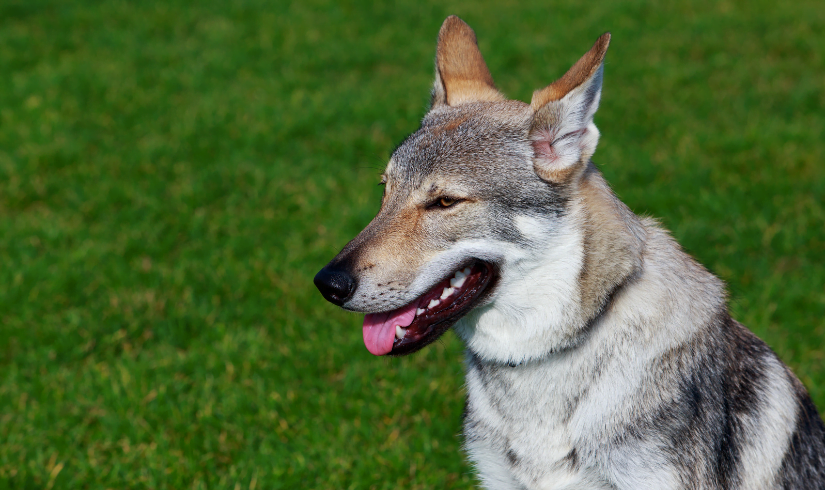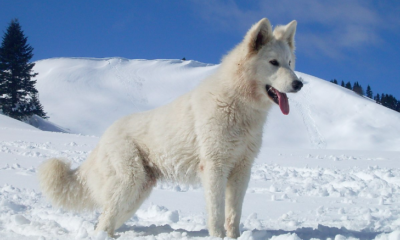Dogs
Wolf-Inspired Elegance: Unveiling the Charisma of Wolf-Like Dog Breeds
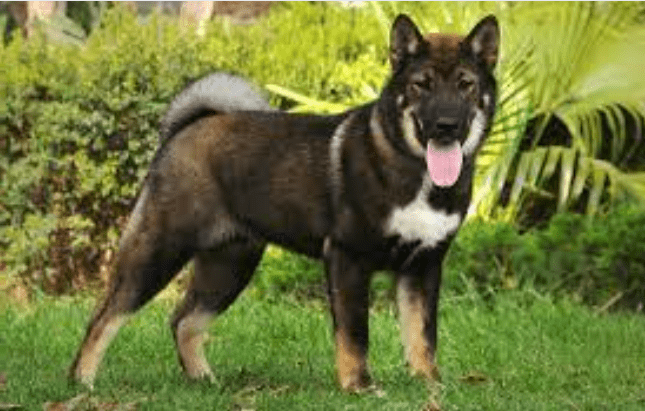
Wolf-Inspired Elegance: Unveiling the Charisma of Wolf-Like Dog Breeds
If you’ve ever dreamt of having a wild and majestic wolf-like companion without the untamed behavior, you’re in for a treat!
These 10 dog breeds exude the spirit of the wilderness while being the perfect, domesticated additions to your family.
Let’s dive into the fascinating world of wolf-like dog breeds that are anything but wild.
Alaskan Malamute: Power and Grace
The Alaskan Malamute is a breed that stands out with its impressive combination of power and grace.
Originating from the harsh Arctic regions of Alaska, these majestic dogs were originally developed by the indigenous Inuit people for hauling heavy freight over long distances.
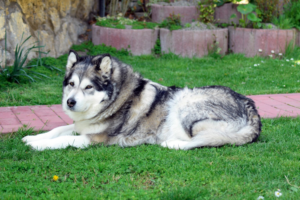
1. Physical Characteristics: A Wolf in Dog’s Clothing
With their wolf-like appearance, the Alaskan Malamutes possess a robust and sturdy build. Their thick double coat, designed to withstand frigid temperatures, comes in various colors, including shades of gray, sable, and red.
Their erect ears and plumed tails contribute to their distinctive and regal appearance, resembling their wild ancestors.
2. Strength and Endurance: True Working Dogs
Known for their exceptional strength and endurance, Alaskan Malamutes are true working dogs at heart. Their powerful shoulders and hindquarters, combined with a deep chest, allow them to pull heavy sleds through snow-covered landscapes.
This strength, coupled with a friendly disposition, makes them excellent family companions.
3. Loyal and Sociable: A True Family Companion
Despite their imposing appearance, Alaskan Malamutes are remarkably affectionate and loyal. They thrive in a family environment and form strong bonds with their human pack.
Their sociable nature makes them excellent with children, although early socialization and training are essential to ensure their well-mannered behavior.
4. Exercise Needs: Keep Them Moving
These dogs have a high energy level and an innate desire to work. Daily exercise is crucial to keep them physically and mentally stimulated.
Regular walks, vigorous play sessions, and engaging activities like hiking or pulling a sled-like cart can help channel their energy positively.
5. Grooming: Maintaining the Majestic Coat
The luxurious double coat of the Alaskan Malamute requires regular grooming to prevent matting and keep it healthy.
Brushing several times a week helps remove loose fur and keeps the coat shiny. Additionally, they shed more during seasonal changes, requiring extra attention during those times.
6. Training: Consistent Leadership is Key
While intelligent, Alaskan Malamutes can be independent, requiring firm and consistent training. Early socialization is crucial to ensure they grow into well-behaved adults. Positive reinforcement techniques work best, as these dogs respond well to praise and treats.
7. Health Considerations: Vigilant Care Required
Like all breeds, Alaskan Malamutes have specific health considerations. Regular veterinary check-ups, a balanced diet, and attention to their joint health are essential. Being aware of common breed-specific issues, such as hip dysplasia, can aid in preventive care.
Husky: Siberian Elegance and Playful Spirit
The Husky, with its enchanting blue eyes and thick double coat, embodies a perfect blend of Siberian elegance and a playful spirit.
Originating from the vast and icy regions of Siberia, these dogs were initially bred by the Chukchi people for pulling light loads across long distances, showcasing both beauty and utility.
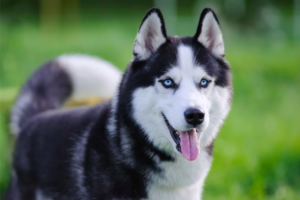
1. Distinctive Appearance: Mesmerizing Blue Eyes and Unique Coat
One of the most striking features of the Husky is its captivating blue eyes, often appearing as though they hold the secrets of the snowy landscapes they hail from.
Their thick double coat comes in various color patterns, including black, gray, red, and agouti. The coat not only provides insulation in cold temperatures but also contributes to their distinctive wolf-like appearance.
2. Friendly and Outgoing: A Social Butterfly
Huskies are renowned for their friendly and outgoing nature. Unlike some more reserved breeds, these dogs thrive on social interactions and love being a part of a bustling family.
Their affable demeanor makes them excellent companions for families, especially those with an active lifestyle.
3. Intelligence and Independence: A Unique Combination
Huskies are known for their intelligence, but they also possess a streak of independence. This combination can make training an interesting experience, as they are quick learners but may choose to do things their own way.
Consistent training with positive reinforcement is crucial to harness their intelligence effectively.
4. Energetic and Playful: Always Up for Adventure
The Husky’s energy levels are boundless, and they have a natural inclination for playfulness. Regular exercise is not just a preference but a necessity for these dogs.
Engaging in activities like jogging, hiking, or even pulling a sled (a nod to their historical purpose) keeps them physically and mentally stimulated.
5. Howling Communication: Vocal and Expressive
Huskies are known for their vocalizations, including howling, which adds to their unique charm. While they may not bark as much as other breeds, their expressive vocal range is something to be embraced.
Understanding their communication style helps build a strong bond between the dog and their family.
6. Grooming: Maintaining the Fluffy Coat
Their thick double coat, while beautiful, requires regular grooming to prevent matting and reduce shedding. Brushing a few times a week helps keep their coat healthy, and during shedding seasons, more frequent grooming is necessary to manage the extra fur.
7. Cold Weather Tolerance: Thriving in Chilly Climates
Given their Siberian heritage, Huskies are well-equipped to handle cold weather. Their dense coat and furry tails even serve as natural insulation. However, they may struggle in extremely hot climates, so adequate shade and hydration are essential.
German Shepherd: Intelligent Guardians with a Noble Presence
The German Shepherd, renowned for its intelligence and noble presence, is a versatile breed that excels in various roles. Originating from Germany, these dogs were initially bred for herding, showcasing their keen intellect and remarkable work ethic.
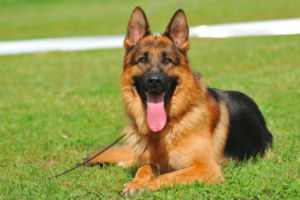
1. Distinctive Appearance: Stalwart and Wolf-Like
German Shepherds are instantly recognizable with their upright ears, sharp expressions, and a sleek double coat that can be tan, black, or sable.
Their wolf-like appearance, combined with a well-muscled and agile build, adds to their regal charm. This breed emanates strength and confidence, making them an ideal choice for various roles, from family protector to police or military service.
2. Intelligence: Quick Learners and Problem Solvers
Known for their exceptional intelligence, German Shepherds are quick learners and adept problem solvers. This makes them highly trainable for various tasks, and they thrive on mental stimulation.
Consistent training from an early age is crucial to harness their intelligence effectively.
3. Loyalty and Protective Instincts: Family Guardians
German Shepherds are fiercely loyal to their families and often form deep bonds with their human pack. Their natural protective instincts make them excellent family guardians, providing a sense of security to those they love.
Proper socialization from a young age ensures that their protective nature is well-balanced.
4. Versatility in Roles: From Herding to Service Work
Beyond being beloved family pets, German Shepherds excel in various roles, including herding, search and rescue, police work, and as service dogs. Their versatility is a testament to their intelligence, adaptability, and strong work ethic.
5. Energetic and Active: Exercise is Essential
German Shepherds are high-energy dogs that require regular exercise to keep them physically and mentally stimulated. Daily walks, playtime, and engaging activities like agility training contribute to a healthy and happy German Shepherd.
6. Grooming: Maintaining the Elegant Coat
Their double coat requires regular grooming to keep it healthy and free from mats. Brushing a few times a week helps manage shedding and keeps their coat looking sleek.
Regular grooming sessions also provide an opportunity to check for any signs of skin issues or other health concerns.
7. Health Considerations: Proactive Care is Key
Like all breeds, German Shepherds are prone to certain health issues, including hip dysplasia and elbow dysplasia. Regular veterinary check-ups, a balanced diet, and maintaining a healthy weight are crucial for their overall well-being.
Wolfdog: The Enigmatic Blend
Wolfdogs are a captivating hybrid, merging the domesticated loyalty of dogs with the untamed spirit of wolves. This enigmatic blend creates a canine companion that stands out for its unique characteristics and intriguing allure.
Let’s delve into the fascinating world of Wolfdogs:
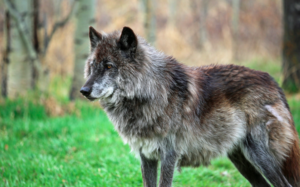
1. Heritage and Origins: A Unique Crossbreed
Wolfdogs are the result of breeding domestic dogs with wolves, creating a mesmerizing combination of the two species.
This intentional crossbreeding aims to capture the physical prowess and distinctive appearance of wolves while maintaining the trainable and affectionate qualities of domestic dogs.
2. Appearance: Striking Resemblance to the Wild
The most noticeable feature of Wolfdogs is their striking resemblance to wolves. They often have the pointed ears, bushy tails, and piercing eyes characteristic of their wild ancestors.
The coat color and patterns can vary, but the overall impression is one of a creature closely tied to the wilderness.
3. Temperament: A Balancing Act
Wolfdogs inherit traits from both dogs and wolves, resulting in a temperament that requires careful consideration. While they can be loyal, intelligent, and affectionate like dogs, they may also retain some wolf-like instincts, such as a strong sense of independence.
Proper socialization and positive reinforcement training from an early age are crucial to finding the right balance in their behavior.
4. Socialization Challenges: Understanding the Wild Side
Socializing Wolfdogs can be more challenging compared to traditional dog breeds due to their wolf heritage.
Their instincts may incline them to be more reserved or cautious, emphasizing the importance of exposing them to various environments, people, and animals from a young age to foster positive social behaviors.
5. Legal Considerations: Navigating Ownership
Owning a Wolfdog may come with legal considerations and restrictions. Some regions have specific regulations due to the wolf content in these hybrids.
It’s essential for potential owners to be aware of local laws, permits, and requirements to ensure responsible ownership.
6. Exercise and Mental Stimulation: Meeting Wild Needs
Wolfdogs are active and intelligent creatures that require ample physical and mental stimulation. Engaging them in activities that mimic their wild instincts, such as scent games and puzzle toys, helps satisfy their need for mental challenges.
A secure outdoor space for exercise is vital to accommodate their energetic nature.
7. Bonding and Leadership: Building Trust
Building a strong bond with a Wolfdog involves establishing trust and demonstrating consistent leadership. They respond well to positive reinforcement, and a firm yet gentle approach in training helps foster a harmonious relationship.
Earning their trust is a rewarding process that solidifies the unique connection between the Wolfdog and its human companions.
Czechoslovakian Wolfdog: An Elegant Fusion
The Czechoslovakian Wolfdog stands out as a captivating breed, born from the deliberate fusion of a German Shepherd and Carpathian Wolf.
This elegant blend results in a dog that not only possesses the physical grace of a wolf but also the intelligence and trainability inherent in the German Shepherd lineage.
Let’s explore the unique characteristics that make the Czechoslovakian Wolfdog an extraordinary and elegant companion:
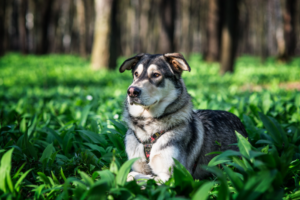
1. Appearance: A Symphony of Wolf-Like Features
The Czechoslovakian Wolfdog boasts a remarkable resemblance to its wild ancestors. With erect ears, a bushy tail, and a dense, wolf-like coat, this breed exudes a majestic aura.
Their coat color often mirrors the agouti pattern found in wolves, further enhancing their visual connection to the untamed wilderness.
2. Size and Build: Striking a Balance
These dogs strike a harmonious balance in size, falling between a German Shepherd and a Carpathian Wolf. The result is a medium to large-sized breed with a sturdy build that reflects strength and agility.
Their physical traits align with both the resilience needed for survival in the wild and the adaptability required for domestication.
3. Temperament: A Unique Blend of Traits
The Czechoslovakian Wolfdog inherits a blend of temperamental characteristics from its German Shepherd and Carpathian Wolf lineage.
While they may be reserved and cautious like a wolf, they also exhibit the loyalty and trainability typical of German Shepherds. Striking the right balance in their temperament requires early socialization and positive reinforcement training.
4. Intelligence: The Legacy of German Shepherds
Intelligence is a defining trait inherited from the German Shepherd side of their heritage. Czechoslovakian Wolfdogs are quick learners and possess problem-solving abilities.
This intelligence, coupled with their strong instincts, makes them suitable for various activities, including obedience trials and agility training.
5. Adaptability: Thriving in Varied Environments
Despite their wild appearance, Czechoslovakian Wolfdogs are adaptable to domestic life. They can thrive in different environments, provided they receive proper mental and physical stimulation.
Engaging them in activities that stimulate their senses and mimic their natural instincts contributes to their overall well-being.
6. Exercise Needs: An Active Lifestyle
These dogs have a high energy level and require regular exercise to maintain both physical and mental health. Long walks, interactive play, and opportunities for exploring their surroundings help satiate their innate need for activity.
A well-exercised Czechoslovakian Wolfdog is more likely to exhibit well-balanced behavior.
7. Grooming: Maintaining the Elegant Coat
While their dense, double coat offers protection against various weather conditions, regular grooming is necessary. Brushing helps manage shedding and keeps the coat in good condition.
Additionally, routine inspections of ears, eyes, and teeth contribute to their overall grooming care.
Saarloos Wolfdog: Majestic Heritage Unleashed
The Saarloos Wolfdog stands as a captivating breed, a result of crossing a German Shepherd with an Eurasian Wolf.
This deliberate fusion gives rise to a dog that not only possesses the striking appearance of a wolf but also retains the noble and reserved nature of its wild ancestors. Here are key aspects that illuminate the majesty of the Saarloos Wolfdog:
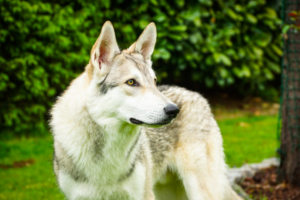
1. Appearance: A Harmonious Blend of Wolf and Dog
The Saarloos Wolfdog is a visual symphony of wolf-like features. With a thick, dense coat, pointed ears, and a bushy tail, these dogs exude a majestic aura reminiscent of the untamed wilderness.
Their coat colors often reflect the agouti pattern found in wolves, adding to their visual allure.
2. Size and Build: Reflecting Strength and Elegance
Inheriting characteristics from both the German Shepherd and the Eurasian Wolf, the Saarloos Wolfdog boasts a well-balanced size and build.
They are large, muscular dogs with a graceful and elegant posture, embodying strength and agility. This physical blend contributes to their regal presence.
3. Temperament: Reserved Dignity
Saarloos Wolfdogs exhibit a reserved and dignified temperament, mirroring the aloof nature of their wolf ancestors. While loyal and affectionate with their human pack, they may be cautious and reserved with strangers.
Early socialization plays a crucial role in shaping their temperament, ensuring a balanced and well-behaved companion.
4. Intelligence: A Legacy of German Shepherds
Intelligence is a notable trait inherited from the German Shepherd lineage. Saarloos Wolfdogs are quick learners and possess a keen understanding of their surroundings.
Their intelligence, coupled with their independent nature, requires consistent training and mental stimulation to channel their abilities positively.
5. Adaptability: Thriving in Varied Environments
Despite their wolf-like appearance, Saarloos Wolfdogs can adapt well to domestic life. However, they thrive best in environments that provide ample space for physical activity and mental stimulation.
Engaging them in activities that allow them to use their instincts, such as scent games or obedience training, contributes to their overall well-being.
6. Exercise Needs: Satisfying the Wild Spirit
These dogs have an active and energetic spirit, requiring regular exercise to maintain their physical and mental health. Long walks, vigorous play sessions, and opportunities for exploration align with their natural instincts and help satiate their need for activity.
A well-exercised Saarloos Wolfdog is more likely to exhibit balanced behavior.
7. Grooming: Maintaining the Majestic Coat
The Saarloos Wolfdog’s double coat, while contributing to their majestic appearance, requires regular grooming.
Brushing helps manage shedding and keeps the coat in good condition. Additionally, routine inspections of ears, eyes, and teeth contribute to their overall grooming care.
Tamaskan: Nordic Elegance and Spirit
The Tamaskan is a lesser-known beauty, a breed that encapsulates the elegance and spirit of the Nordic wilderness.
Originating from Finland, these dogs are a relatively recent creation, bred to resemble the majestic appearance of wolves while maintaining a friendly and cooperative temperament. Here’s a closer look at the lesser-known beauty, the Tamaskan:
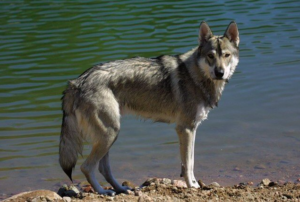
1. Appearance: Nordic Wolf Aesthetics
The Tamaskan is recognized for its stunning resemblance to wolves. With a thick double coat, erect ears, and a bushy tail, these dogs emanate the allure of their Arctic ancestors.
Their coat colors range from red-gray to wolf gray, capturing the essence of the wild and adding to their visual appeal.
2. Size and Build: Medium Stature with Strength
Tamaskans are medium to large-sized dogs with a well-balanced and athletic build. Their strength, coupled with agility, reflects their original purpose of sled pulling.
Despite their wolf-like appearance, their friendly demeanor makes them an ideal choice for families seeking a unique yet approachable companion.
3. Temperament: Gentle and Social Nature
In contrast to their wild appearance, Tamaskans are known for their gentle and social nature. They form strong bonds with their families and are generally good with children and other pets.
Early socialization is essential to reinforce their friendly temperament and ensure positive interactions in various situations.
4. Intelligence: Quick Learners with a Cooperative Spirit
Tamaskans exhibit intelligence and a cooperative spirit, making them quick learners in training sessions. They thrive on mental stimulation and enjoy engaging activities that challenge their problem-solving skills.
This combination of intelligence and cooperation enhances their suitability as both working dogs and family companions.
5. Adaptability: Well-Suited to Various Environments
Tamaskans adapt well to various environments, provided they receive sufficient exercise and mental stimulation. Their original sled-pulling heritage indicates their endurance and adaptability to colder climates.
Regular outdoor activities, such as walks and interactive play, contribute to their overall well-being.
6. Exercise Needs: Energetic Spirits at Play
Tamaskans have energetic spirits that require regular exercise to maintain their physical health and mental well-being.
Outdoor activities, such as hiking, running, and even engaging in dog sports, align with their heritage and contribute to a satisfied and content Tamaskan.
7. Grooming: Maintaining the Nordic Coat
Their thick double coat requires regular grooming to manage shedding and prevent matting. Brushing a few times a week helps keep their coat healthy, especially during seasonal shedding.
Routine checks for ears, eyes, and teeth contribute to their overall grooming care.
Canadian Eskimo Dog: Arctic Majesty Unleashed
The Canadian Eskimo Dog is a lesser-known gem, a breed that embodies the raw beauty and resilience of the Arctic. Originating from Canada, these dogs are a testament to the strength and endurance required to navigate the unforgiving landscapes of the North.
Here’s an exploration of the Canadian Eskimo Dog, a majestic and lesser-known beauty:
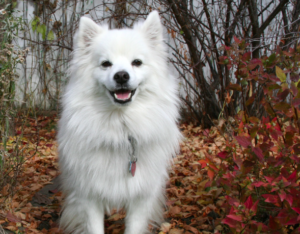
1. Appearance: A Polar Presence
With a dense double coat, erect triangular ears, and a bushy tail that curls over the back, the Canadian Eskimo Dog proudly wears its Arctic heritage.
These dogs often come in a range of colors, including white, black, gray, and sable, creating a stunning contrast against the snowy landscapes they historically traversed.
2. Size and Build: Sturdy and Powerful
Canadian Eskimo Dogs are robust and muscular, displaying a powerful build that reflects their original purpose as sled dogs.
Their strength and endurance allow them to pull heavy loads across vast distances, making them indispensable for the Inuit people in the Arctic regions.
3. Temperament: Independent and Loyal
Known for their independent nature, Canadian Eskimo Dogs also exhibit unwavering loyalty to their human pack. This breed has a strong sense of hierarchy, making them responsive to consistent leadership.
Early socialization is essential to instill good behavior and ensure compatibility with other pets and family members.
4. Intelligence: Problem-Solving Prowess
Canadian Eskimo Dogs are intelligent and possess problem-solving abilities, traits honed by generations of survival in harsh environments. This intelligence, combined with their independent spirit, requires patient and consistent training to channel their skills positively.
5. Adaptability: Arctic Survivors in Any Climate
Despite their Arctic origins, Canadian Eskimo Dogs can adapt to various climates. However, they thrive best in colder environments, thanks to their thick coat and insulating undercoat. Adequate shade and hydration are essential in warmer weather to ensure their well-being.
6. Exercise Needs: Sled Dog Legacy
As descendants of sled dogs, Canadian Eskimo Dogs have high energy levels and a strong desire for physical activity. Regular exercise, including long walks, runs, and engaging in dog sports, is crucial to keep them physically and mentally stimulated.
This active lifestyle aligns with their historical purpose and contributes to a happy and healthy Canadian Eskimo Dog.
7. Grooming: Maintaining the Arctic Coat
Their dense double coat requires regular grooming to manage shedding and prevent matting. Brushing at least twice a week helps keep their coat healthy, especially during seasonal changes.
Regular checks for ears, eyes, and teeth contribute to their overall grooming care.
Shikoku: Japan’s Hidden Gem
The Shikoku, often dubbed as Japan’s hidden gem, is a lesser-known beauty with deep historical roots. Hailing from the mountainous regions of Shikoku Island, Japan, these dogs possess a unique blend of elegance, intelligence, and loyalty.
Let’s delve into the distinctive characteristics that make the Shikoku a captivating and lesser-known beauty:
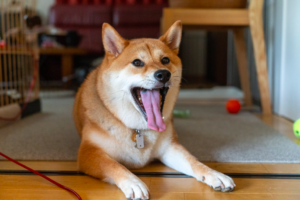
1. Appearance: Compact and Stately
The Shikoku is a medium-sized dog with a well-proportioned and compact build. Their fox-like face, curled tail, and erect triangular ears contribute to their captivating appearance.
Their double coat, which comes in red, black and tan, or sesame colors, adds to their visual appeal, creating a stately and graceful presence.
2. Temperament: Proud and Loyal
Shikokus are known for their proud and loyal nature. While they may be reserved with strangers, they form strong bonds with their families.
This loyalty, combined with their alertness, makes them excellent watchdogs. Early socialization is key to ensuring they develop a well-balanced and well-behaved temperament.
3. Intelligence: Keen and Independent Thinkers
Intelligence is a prominent trait in Shikokus. They are independent thinkers, often showcasing problem-solving skills.
This intelligence, coupled with a strong will, requires consistent training and a firm yet gentle approach to harness their abilities positively.
4. Adaptability: Versatile and Agile
Shikokus are versatile dogs that adapt well to different environments. Their agility and endurance are well-suited to the mountainous terrains of Shikoku Island.
While they thrive in an active lifestyle, they can adjust to varying climates, making them suitable companions for those who appreciate both indoor and outdoor activities.
5. Exercise Needs: Active Explorers
These dogs have a moderate to high energy level, requiring regular exercise to keep them physically and mentally stimulated. Daily walks, interactive play sessions, and opportunities for exploration align with their adventurous spirit.
Engaging them in activities that challenge their agility and intelligence contributes to their overall well-being.
6. Grooming: Maintaining the Elegant Coat
Shikokus have a thick double coat that requires regular grooming. Brushing a few times a week helps manage shedding and keeps their coat healthy.
Routine checks for ears, eyes, and teeth contribute to their overall grooming care, ensuring they look as elegant as their Japanese heritage suggests.
Conclusion
In conclusion, these 10 wolf-like dog breeds offer a perfect balance between the allure of the wild and the warmth of a domesticated companion.
Whether you’re drawn to the strength of the Alaskan Malamute or the intelligence of the German Shepherd, each breed brings something special to the table.
Questions People Also AsK: (FAQs)
Are wolf-like breeds suitable for families with children?
Yes, many of these breeds are known for their gentle and loyal nature, making them great family pets.
Do wolf-like breeds require special grooming?
Yes, some breeds, like the Husky and Tamaskan, have thick coats that need regular brushing to keep them healthy.
Are wolfdogs legal to own as pets?
Ownership regulations vary, so it’s essential to check local laws and ensure proper care and training.
Do these breeds get along with other pets?
Proper socialization from an early age can help them coexist with other pets, but individual temperament varies.
What kind of exercise do these breeds need?
Most of these breeds are energetic and require regular exercise, including walks, playtime, and mental stimulation.
We appreciate you for taking the time to read this article!
Finally, we hope you found this article interesting? And what do you think about ”Parvo Symptoms: What Every Pet Parent Needs to Know!?”
Please feel free to share or inform your friends about this article and this site, thanks!
And let us know if you observe something that isn’t quite right.
Dogs
Exploring the Diverse World of Dog Breeds: A Look at the Seven Main Groups + the others

Exploring the Diverse World of Dog Breeds: A Look at the Seven Main Groups + the others
Dogs are one of the most diverse species on the planet, with hundreds of different breeds that vary widely in size, shape, temperament, and behavior. To help organize this diversity, dog breeds are often grouped into categories based on their original purpose or characteristics.
These groups, recognized by kennel clubs and breed organizations worldwide, provide a framework for understanding the different types of dogs and their typical traits. Here are the main groups of dogs:
- Sporting Group: These dogs were bred for hunting game birds, both on land and in the water. They are known for their stamina, intelligence, and willingness to please. Breeds in this group include the Labrador Retriever, Golden Retriever, and English Springer Spaniel.
- Hound Group: Hounds are known for their keen sense of smell and ability to track prey. They are often used for hunting and tracking game. Breeds in this group include the Beagle, Bloodhound, and Greyhound.
- Working Group: Dogs in this group were bred for specific tasks, such as guarding property, pulling sleds, or performing water rescues. They are known for their strength, intelligence, and trainability. Breeds in this group include the Siberian Husky, Boxer, and Great Dane.
- Terrier Group: Terriers were originally bred to hunt and kill vermin. They are known for their feisty and energetic nature. Breeds in this group include the Jack Russell Terrier, Bull Terrier, and Scottish Terrier.
- Toy Group: Toy breeds are small companion dogs that were bred for their portable size and charming personalities. They are often kept as lap dogs or companions. Breeds in this group include the Chihuahua, Pomeranian, and Shih Tzu.
- Non-Sporting Group: This group is a diverse collection of breeds that don’t fit into other categories. They vary widely in size, coat type, and temperament. Breeds in this group include the Bulldog, Poodle, and Dalmatian.
- Herding Group: These dogs were bred to control the movement of other animals, such as sheep or cattle. They are known for their intelligence, agility, and strong herding instincts. Breeds in this group include the Border Collie, Australian Shepherd, and German Shepherd Dog.
Each group has its own unique characteristics and traits, but all dogs share a common bond with humans as loyal companions and working partners. Understanding these groups can help you choose a breed that fits your lifestyle and preferences.
Sporting Group
- American Water Spaniel
- Boykin Spaniel
- Chesapeake Bay Retriever
- Clumber Spaniel
- Curly-Coated Retriever
- English Setter
- Flat-Coated Retriever
- Gordon Setter
- Irish Red and White Setter
- Irish Setter
- Irish Water Spaniel
- Nova Scotia Duck Tolling Retriever
- Pointer
- Spinone Italiano
- Sussex Spaniel
- Vizsla
- Weimaraner
- Welsh Springer Spaniel
- Wirehaired Pointing Griffon
Hound Group
- Afghan Hound
- American English Coonhound
- American Foxhound
- Basenji
- Black and Tan Coonhound
- Borzoi
- Cirneco dell’Etna
- Finnish Spitz
- Grand Basset Griffon Vendéen
- Greyhound
- Harrier
- Ibizan Hound
- Norwegian Elkhound
- Otterhound
- Petit Basset Griffon Vendéen
- Pharaoh Hound
- Plott
- Portuguese Podengo
- Redbone Coonhound
- Rhodesian Ridgeback
- Saluki
- Scottish Deerhound
- Sloughi
- Treeing Walker Coonhound
- Whippet
Working Group
- Akita
- Alaskan Malamute
- Anatolian Shepherd Dog
- Bernese Mountain Dog
- Black Russian Terrier
- Boerboel
- Boxer
- Bullmastiff
- Cane Corso
- Dogo Argentino
- Dogue de Bordeaux
- Greater Swiss Mountain Dog
- Great Pyrenees
- Komondor
- Kuvasz
- Leonberger
- Mastiff
- Neapolitan Mastiff
- Newfoundland
- Rottweiler
- Samoyed
- Siberian Husky
- St. Bernard
- Tibetan Mastiff
Terrier Group
- Airedale Terrier
- American Staffordshire Terrier
- Australian Terrier
- Bedlington Terrier
- Border Terrier
- Bull Terrier
- Cairn Terrier
- Cesky Terrier
- Dandie Dinmont Terrier
- Glen of Imaal Terrier
- Irish Terrier
- Kerry Blue Terrier
- Lakeland Terrier
- Manchester Terrier
- Miniature Bull Terrier
- Miniature Schnauzer
- Norfolk Terrier
- Norwich Terrier
- Parson Russell Terrier
- Russell Terrier
- Scottish Terrier
- Sealyham Terrier
- Skye Terrier
- Smooth Fox Terrier
- Soft Coated Wheaten Terrier
- Staffordshire Bull Terrier
- Welsh Terrier
- West Highland White Terrier
- Wire Fox Terrier
Toy Group
- Affenpinscher
- Brussels Griffon
- Cavalier King Charles Spaniel
- Chihuahua
- Chinese Crested
- English Toy Spaniel
- Havanese
- Italian Greyhound
- Japanese Chin
- Maltese
- Manchester Terrier (Toy)
- Miniature Pinscher
- Papillon
- Pekingese
- Pomeranian
- Poodle (Toy)
- Pug
- Shih Tzu
- Silky Terrier
- Toy Fox Terrier
- Yorkshire Terrier
Non-Sporting Group
- American Eskimo Dog
- Bichon Frise
- Boston Terrier
- Bulldog
- Chinese Shar-Pei
- Chow Chow
- Dalmatian
- Finnish Spitz
- French Bulldog
- Keeshond
- Lhasa Apso
- Lowchen
- Norwegian Lundehund
- Poodle (Miniature)
- Schipperke
- Shiba Inu
- Tibetan Spaniel
- Tibetan Terrier
- Xoloitzcuintli
Herding Group
- Australian Cattle Dog
- Australian Shepherd
- Bearded Collie
- Belgian Malinois
- Belgian Sheepdog
- Belgian Tervuren
- Border Collie
- Bouvier des Flandres
- Briard
- Canaan Dog
- Cardigan Welsh Corgi
- Collie (Rough)
- Collie (Smooth)
- German Shepherd Dog
- Icelandic Sheepdog
- Miniature American Shepherd
- Norwegian Buhund
- Old English Sheepdog
- Pembroke Welsh Corgi
- Polish Lowland Sheepdog
- Puli
- Pyrenean Shepherd
- Shetland Sheepdog
- Spanish Water Dog
- Swedish Vallhund
Miscellaneous Class
- American Hairless Terrier
- Barbet
- Biewer Terrier
- Boerboel
- Coton de Tulear
- Czechoslovakian Vlcak
- Lagotto Romagnolo
- Mudi
- Nederlandse Kooikerhondje
- Peruvian Inca Orchid
- Portuguese Podengo
- Rat Terrier
- Russian Toy
- Sloughi
- Thai Ridgeback
- Xoloitzcuintli
Rare Breeds
- Azawakh
- Bergamasco
- Chinook
- Cirneco dell’Etna
- Dandie Dinmont Terrier
- Finnish Lapphund
- Finnish Spitz
- Grand Basset Griffon Vendéen
- Kooikerhondje
- Lagotto Romagnolo
- Lowchen
- Norwegian Lundehund
- Otterhound
- Peruvian Inca Orchid
- Schipperke
- Sealyham Terrier
- Skye Terrier
- Sussex Spaniel
- Swedish Vallhund
- Tibetan Mastiff
Designer and Hybrid Breeds
- Labradoodle (Labrador Retriever + Poodle)
- Goldendoodle (Golden Retriever + Poodle)
- Cockapoo (Cocker Spaniel + Poodle)
- Pomsky (Pomeranian + Husky)
- Maltipoo (Maltese + Poodle)
- Cavapoo (Cavalier King Charles Spaniel + Poodle)
- Yorkipoo (Yorkshire Terrier + Poodle)
- Sheepadoodle (Old English Sheepdog + Poodle)
- Bernedoodle (Bernese Mountain Dog + Poodle)
- Aussiedoodle (Australian Shepherd + Poodle)
- Shih-Poo (Shih Tzu + Poodle)
- Boxerdoodle (Boxer + Poodle)
- Schnoodle (Schnauzer + Poodle)
- Chorkie (Chihuahua + Yorkshire Terrier)
- Puggle (Pug + Beagle)
- Cockapoo (Cocker Spaniel + Poodle)
- Labradoodle (Labrador Retriever + Poodle)
- Goldendoodle (Golden Retriever + Poodle)
- Cockapoo (Cocker Spaniel + Poodle)
- Pomsky (Pomeranian + Husky)
- Maltipoo (Maltese + Poodle)
- Cavapoo (Cavalier King Charles Spaniel + Poodle)
- Yorkipoo (Yorkshire Terrier + Poodle)
- Sheepadoodle (Old English Sheepdog + Poodle)
- Bernedoodle (Bernese Mountain Dog + Poodle)
- Aussiedoodle (Australian Shepherd + Poodle)
- Shih-Poo (Shih Tzu + Poodle)
- Boxerdoodle (Boxer + Poodle)
- Schnoodle (Schnauzer + Poodle)
- Chorkie (Chihuahua + Yorkshire Terrier)
- Puggle (Pug + Beagle)
Rare and Uncommon Breeds
- Bergamasco Shepherd
- Catahoula Leopard Dog
- Chinook
- Finnish Spitz
- Glen of Imaal Terrier
- Kooikerhondje
- Lagotto Romagnolo
- Mudi
- Otterhound
- Peruvian Inca Orchid
- Portuguese Podengo
- Pyrenean Shepherd
- Russian Toy
- Saluki
- Sloughi
- Swedish Vallhund
- Tibetan Mastiff
- Toy Fox Terrier
- Xoloitzcuintli
Conclusion
In conclusion, the world of dogs is incredibly diverse, with hundreds of breeds that vary widely in size, shape, temperament, and behavior. To help categorize this diversity, dog breeds are grouped into categories based on their original purpose or characteristics.
These groups, such as the Sporting Group, Hound Group, Working Group, Terrier Group, Toy Group, Non-Sporting Group, and Herding Group, provide a framework for understanding the different types of dogs and their typical traits.
Each group has its own unique characteristics and traits, but all dogs share a common bond with humans as loyal companions and working partners. Whether you’re looking for a hunting companion, a family pet, a working dog, or a lap dog, there’s a breed out there for everyone.
Understanding these groups can help you choose a breed that fits your lifestyle and preferences, ensuring a happy and fulfilling relationship between you and your canine companion.
Frequently Asked Questions (FAQs)
What are some breeds in the Sporting Group, and what are their typical characteristics?
Some breeds in the Sporting Group include the Labrador Retriever, Golden Retriever, and English Springer Spaniel. These breeds are known for their high energy levels, intelligence, and friendly nature. They are often used for hunting and retrieving game.
Which breeds are typically found in the Hound Group, and what sets them apart from other groups?
The Hound Group includes breeds such as the Beagle, Bloodhound, and Greyhound. Hounds are known for their keen sense of smell and ability to track prey. They are often used for hunting and tracking game.
What are some examples of breeds in the Working Group, and what are their common characteristics?
Breeds in the Working Group include the Siberian Husky, Boxer, and Great Dane. These dogs were bred for specific tasks, such as guarding property or pulling sleds. They are known for their strength, intelligence, and trainability.
Can you name a few breeds from the Terrier Group, and what makes them unique?
Terriers, such as the Jack Russell Terrier, Bull Terrier, and Scottish Terrier, were originally bred to hunt and kill vermin. They are known for their feisty nature and high energy levels.
What are some breeds in the Toy Group, and what role do they typically play in households?
The Toy Group includes breeds like the Chihuahua, Pomeranian, and Shih Tzu. These breeds are small in size and are often kept as lap dogs or companions. They are known for their portable size and charming personalities.
We appreciate you for taking the time to read this article!
Finally, we hope you found this article interesting? And what do you think about ”Exploring the Diverse World of Dog Breeds: A Look at the Seven Main Groups!?”
Please feel free to share or inform your friends about this article and this site, thanks!
And let us know if you observe something that isn’t quite right.
Dogs
Comprehensive List of Essential Whelping Kit Items

Comprehensive List of Essential Whelping Kit Items
If you’re just making your start as a dog breeder, you’ve likely got a lot of things on your mind. Finding a suitable mate for your dog, getting them tested—there’s a lot of mental and physical effort that goes into breeding responsibly. One way to make things easier for yourself is assembling your whelping kit early. A whelping kit contains all the necessary items to assist a mother dog during labour and ensure the safe delivery of her puppies.
For both experienced breeders and first-time pet owners, assembling a comprehensive whelping kit can make a significant difference in managing the birthing process. Having everything on-hand is a good idea, as you don’t want to suddenly be stuck without essential items in the midst of delivery.
Comprehensive List of Essential Whelping Kit Items
-
Whelping Box
The first and most crucial item is the whelping box. This is where the mother dog will give birth and care for her puppies during their first weeks of life. It should be spacious enough for the mother to move comfortably but with walls high enough to safely contain the newborn puppies.
-
Clean Towels and Blankets
You’ll need several clean towels to help dry puppies immediately after birth, which stimulates them to breathe and keeps them warm. Soft blankets can be used to line the whelping box for additional comfort.
-
Heating Pad or Heat Lamp
Maintaining a warm environment is essential, especially for newborn puppies who cannot regulate their body temperature. A heating pad or a heat lamp can provide the necessary warmth, but make sure it’s set up to avoid direct contact with the puppies and mother.
-
Digital Thermometer
To monitor the mother’s temperature leading up to labour, which can indicate when birth is imminent. A drop in body temperature is a common sign of labour starting within 24 hours.
-
Disposable Gloves
These are essential for hygiene. Wearing gloves during the delivery helps prevent the spread of infection and allows you to assist with the birth if necessary without introducing contaminants. You also don’t want to be touching anything else with dirty hands, so you may need to use multiple pairs of gloves if you have to operate your phone or move around any other items. Thankfully, a box of gloves is cheap and easy to come by.
-
Antiseptic Solution and Hand Sanitizer
Keeping your hands and the environment clean is crucial. An antiseptic solution can be used for cleaning any instruments or areas around the whelping box, while hand sanitizer should be used before and after assisting with the delivery.
-
Sterile Scissors and Dental Floss
In some cases, you may need to cut the umbilical cords. Sterile scissors are necessary for this task, and unwaxed dental floss can be used to tie off the cords before cutting to prevent bleeding.
-
Aspiration Bulb or Decongestant Syringe
To clear the puppies’ airways of mucus or fluids immediately after birth. It’s crucial for helping puppies who aren’t breathing well on their own initially.
-
Iodine Solution
After cutting the umbilical cord, applying iodine to the end helps prevent infection in the newborn puppy.
-
Puppy Feeding Kit
Includes bottles and appropriate puppy formula in case the mother is unable to nurse her puppies immediately or if there are rejected or weak puppies that need supplementary feeding.
Preparation and Storage Instructions
Organising the Kit
Arrange your whelping kit in order of likely usage. Items needed first, like gloves and towels, should be at the top or in the most accessible part of your storage container.
Storage
Keep the whelping kit in a clean, dry place that’s easily accessible during the whelping process. A portable, waterproof container with compartments can be ideal for quick access and organisation. It’s best to keep the kit in the same room where your dog will be staying, just so you don’t have to go looking for your kit once the time comes.
Preparation
Check and restock your kit well before the expected birthing date. Make sure all consumables are within their expiration date and that reusable items are clean and functional.
Troubleshooting Tips for Common Whelping Challenges
During the birthing process, several issues might arise that require immediate attention. Here are some troubleshooting tips for the most common challenges:
Stuck Puppy
If a puppy seems stuck, first ensure the mother is comfortable and not stressed. Wearing your disposable gloves, you can gently assist by providing mild traction on the puppy with a clean towel. If the puppy does not come free with gentle assistance, call your veterinarian immediately.
Weak Contractions
If the mother dog’s contractions seem weak and she’s having trouble delivering the puppies, a warm, sugar-water solution can help boost her energy. If there’s no improvement, it’s critical to contact your veterinarian, as she may need medication to strengthen contractions or even a caesarean section.
Non-responsive Puppy
If a puppy is not breathing or is too weak to nurse, stay calm. Use the decongestant syringe to clear its airways gently. Rubbing the puppy briskly with a towel can also stimulate breathing. If these methods don’t work, performing a safe puppy CPR and rushing the puppy to a vet is your next step.
Extra Useful Items
While the essentials will cover most situations, having a few additional items on hand can be beneficial:
- Nutritional Supplements for the Mother: Providing the mother with high-energy supplements or a high-calorie diet a few weeks before and after birth can help maintain her strength and improve milk production.
- Puppy Scale: To monitor the puppies’ weight daily, ensuring they are gaining weight and developing healthily.
- Record Keeping Materials: Keeping detailed records of each puppy’s birth time, weight at birth, and daily progress can be crucial, especially in large litters.
Conclusion
Preparing a comprehensive whelping kit and knowing how to use each item effectively can make the whelping easier not only on you, but also on your dog. The peace of mind that comes with knowing that you’re equipped with the right tools can be invaluable.
Remember, while a well-stocked whelping kit is crucial, nothing replaces the expertise of a qualified veterinarian during emergencies. Always have your vet’s number handy, and don’t hesitate to call if the situation becomes too difficult.
FAQs: Comprehensive List of Essential Whelping Kit Items
What is a whelping kit and why is it important?
A whelping kit is a collection of essential items needed to assist a dog during labor and the first few weeks of her puppies’ lives. It is crucial because it helps ensure the health and safety of both the mother and her puppies by providing the necessary tools and supplies to manage the birthing process and immediate postpartum care.
What are the most essential items to include in a whelping kit?
Key items to include in a whelping kit are:
- Whelping box: A clean, safe space for the mother to give birth.
- Clean towels: For drying the puppies and keeping the whelping area clean.
- Disposable gloves: To maintain hygiene during the birthing process.
- Scissors and umbilical clamps: For cutting and securing the umbilical cord.
- Bulb syringe: To clear mucus from the puppies’ airways.
How can I prepare for potential emergencies during whelping?
To prepare for emergencies, you should have:
- Contact information for a vet: In case of complications during birth.
- Puppy milk replacer and bottles: If the mother is unable to nurse.
- Heat source: Such as a heating pad or heat lamp to keep the puppies warm.
- Antiseptic solution: For cleaning any wounds or the umbilical cord area.
- Emergency medical supplies: Including a thermometer, stethoscope, and sterile gauze pads.
What items are necessary for post-whelping care?
For post-whelping care, you will need:
- Puppy scales: To monitor the puppies’ weight gain.
- Puppy ID collars: To identify and keep track of each puppy.
- High-quality puppy food: For when they start weaning.
- Cleaning supplies: Such as disinfectant and puppy pads to maintain a clean environment.
- Record-keeping materials: To document each puppy’s health and progress.
How often should I check on the puppies and mother after birth?
After birth, it is important to check on the puppies and mother frequently:
- First 24 hours: Monitor closely for signs of distress or complications.
- First week: Check every few hours to ensure the puppies are nursing well and gaining weight.
- After the first week: Regular checks multiple times a day to ensure continued health and proper development.
- Ongoing: Maintain a routine of daily health checks and keep the whelping area clean and comfortable.
We appreciate you for taking the time to read this article!
Finally, we hope you found this article interesting? And what do you think about ”Comprehensive List of Essential Whelping Kit Items!?”
Please feel free to share or inform your friends about this article and this site, thanks!
And let us know if you observe something that isn’t quite right.
Dogs
Understanding and Addressing Separation Anxiety in Dogs

Understanding and Addressing Separation Anxiety in Dogs
What is Separation Anxiety?
Separation anxiety is a common behavioral issue in dogs characterized by distress or anxiety when they are separated from their owners or left alone. This condition can manifest in various ways, including excessive barking, destructive behavior, pacing, panting, or even attempts to escape.
Causes of Separation Anxiety
Several factors can contribute to the development of separation anxiety in dogs, including:
- Past Trauma: Dogs that have experienced abandonment, neglect, or traumatic events in the past may be more prone to separation anxiety.
- Change in Routine: Changes in the dog’s routine or environment, such as moving to a new home or the absence of a family member, can trigger separation anxiety.
- Lack of Socialization: Dogs that have not been properly socialized or have not learned to cope with being alone may develop separation anxiety.
- Overdependence on the Owner: Dogs that are overly dependent on their owners for companionship and reassurance may struggle to cope with being alone.
Signs of Separation Anxiety
Recognizing the signs of separation anxiety is crucial for early intervention. Common signs include:
- Excessive barking or howling when left alone
- Destructive behavior, such as chewing furniture or scratching doors
- Pacing, restlessness, or excessive panting
- Urination or defecation inside the house, even if the dog is house-trained
- Attempts to escape or self-injury when confined
Tips for Helping Dogs Cope with Separation Anxiety
- Gradual Desensitization: Gradually acclimate your dog to being alone by leaving for short periods and gradually increasing the duration over time. Use positive reinforcement techniques, such as treats or toys, to create positive associations with alone time.
- Provide Enrichment: Keep your dog mentally and physically stimulated by providing interactive toys, puzzle feeders, or engaging in regular exercise. This can help alleviate boredom and anxiety.
- Create a Safe Space: Designate a comfortable and secure space for your dog to retreat to when you’re not home. This could be a crate, a cozy corner with their bed, or a room with their favorite toys.
- Establish a Routine: Stick to a consistent daily routine to provide structure and predictability for your dog. This can help reduce anxiety and create a sense of security.
- Seek Professional Help: If your dog’s separation anxiety persists despite your efforts, consider seeking guidance from a veterinarian or a certified animal behaviorist. They can provide personalized advice and assistance tailored to your dog’s specific needs.
Conclusion
Separation anxiety can be a challenging issue for both dogs and their owners, but with patience, understanding, and proactive intervention, it is possible to help your dog overcome their anxiety and lead a happier, more balanced life.
By recognizing the signs of separation anxiety, implementing positive reinforcement techniques, and seeking professional guidance when needed, you can support your dog in coping with being alone and strengthen your bond in the process.
FAQs (Frequently Asked Questions)
Can separation anxiety in dogs be cured?
While separation anxiety in dogs can be managed and improved with proper training and intervention, it may not be entirely cured in all cases. However, with patience, consistency, and appropriate support, many dogs can learn to cope better with being alone.
How long does it take to train a dog with separation anxiety?
The time it takes to train a dog with separation anxiety can vary depending on the severity of the anxiety, the dog’s temperament, and the effectiveness of the training methods used. Some dogs may show improvement within a few weeks, while others may require months of consistent training and behavior modification.
Are there medications available to treat separation anxiety in dogs?
In some cases, veterinarians may prescribe medications, such as anti-anxiety medications or antidepressants, to help manage severe cases of separation anxiety in dogs. These medications are typically used in conjunction with behavior modification techniques and should only be prescribed under the guidance of a veterinarian.
Can hiring a pet sitter or dog walker help with separation anxiety?
Hiring a pet sitter or dog walker can be beneficial for dogs with separation anxiety as it provides them with companionship and breaks up their time alone. However, it’s essential to ensure that the pet sitter or dog walker is experienced in handling dogs with separation anxiety and follows any specific instructions or routines provided by the owner.
Can older dogs develop separation anxiety?
Yes, older dogs can develop separation anxiety, particularly if they experience changes in their environment or routine, such as the loss of a companion or a change in living arrangements. It’s essential to monitor older dogs for signs of anxiety and provide appropriate support and intervention when needed.
-

 Pet Care2 years ago
Pet Care2 years agoThe Best Dog Collars For 2022
-

 Dogs2 years ago
Dogs2 years agoBichon Frise: The Happy, Playful, and Cuddly Companion
-

 Trending Pet Stories1 year ago
Trending Pet Stories1 year ago2023 ‘World’s Ugliest Dog’ Winner: Scooter’s Tale of Resilience
-

 Animals2 years ago
Animals2 years agoAre There Animals Having Down Syndrome?
-

 Pets2 years ago
Pets2 years agoThe Fascinating World Of The Red Chameleon
-

 Dogs2 years ago
Dogs2 years agoTop 10 Most Popular Dog Breeds According To AKC.
-

 Dogs2 years ago
Dogs2 years ago21 Dog Breeds That Resemble Bears Or Teddy Bears!
-

 Dogs2 years ago
Dogs2 years agoEskimo Dogs from Canada – What Are They? – Find Out!


